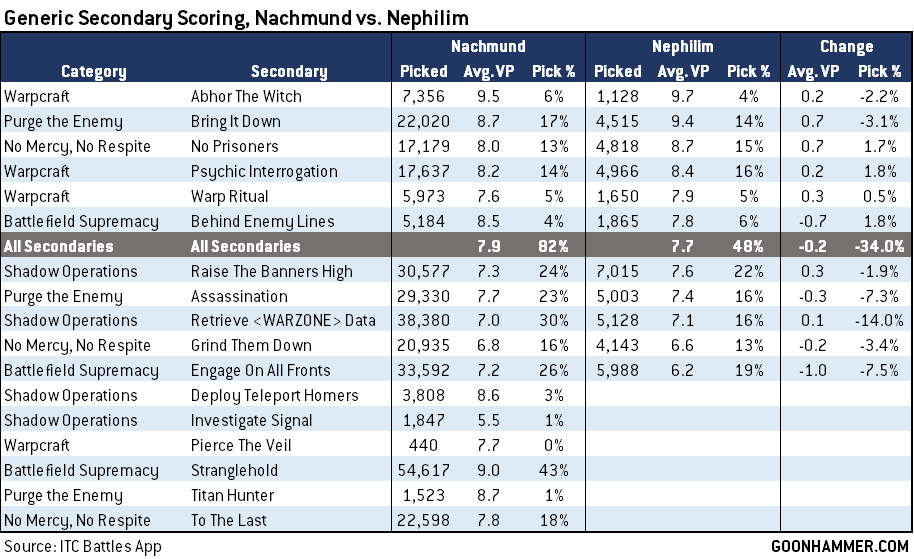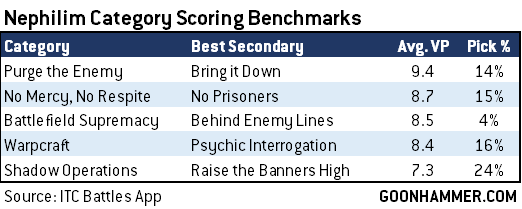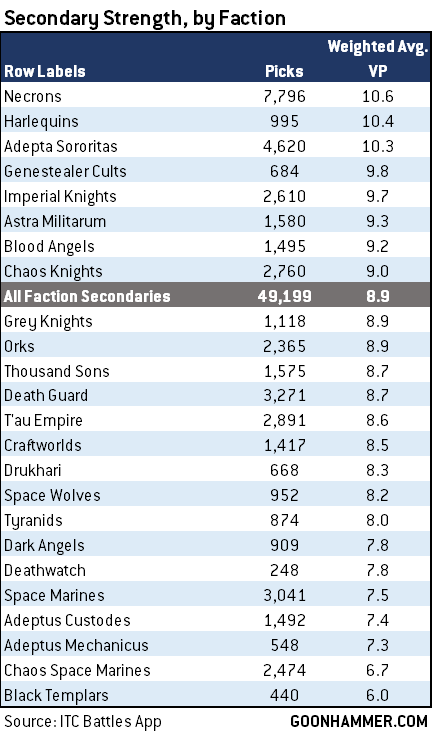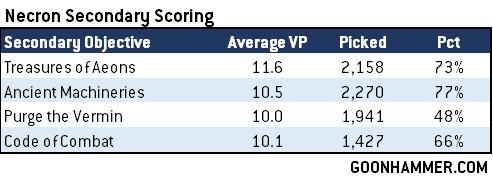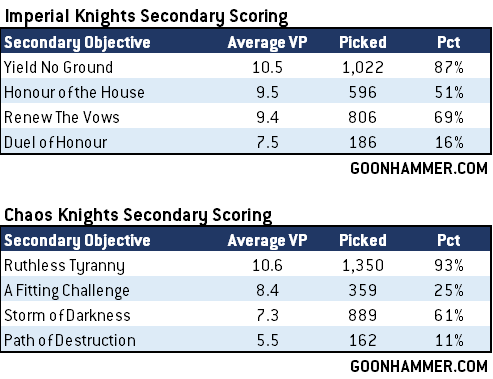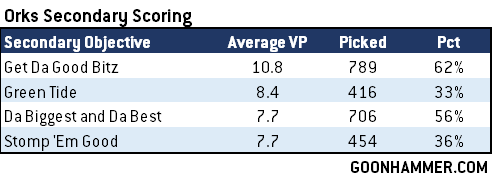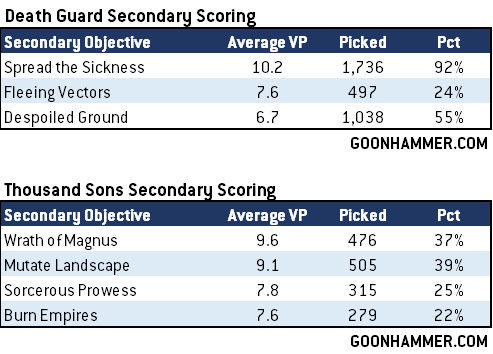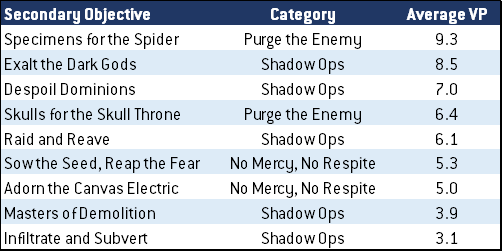Welcome, Dear Reader to another fill-in Hammer of Math. Primaris Kevin couldn’t be here this week so you once again have me filling in with some stats and data from our wonderful dataset over at 40kstats.
The War Zone Nephilim GT Tournament pack absolutely upended the 40k competitive scene, dramatically changing the fortunes of a number of the game’s factions and generally changing how objectives are scored. For those of you unfamiliar, in Nephilim games players can now choose all of their secondary objectives from their faction-specific set, while some key secondaries – namely Stranglehold and To the Last – were removed from the general set available to everyone.
Looking at Nephilim Results
In addition to data from Best Coast Pairings and other tournament apps out there (such as Tabletop.to and Tourneykeeper), we have data from the ITC Battles app, the premier app for tracking games of Warhammer 40k. To-date we’ve collected data on nearly 16 thousand games played with the Nephilim GT pack, covering every faction. While you can find this data on 40kstats – check out the Secondary Scoring page – today I’m going to be doing some additional work with this data and diving in to what it all means.
The Generic Secondary Objectives
Let’s start with the generic secondaries, i.e. those available to every faction.
There’s a lot of great stuff to unpack here, so I’m going to list out the most interesting bits and things to note:
- Generic secondaries see about half as much use. The actual math here around how often they show up in games is tricky, because each game has six secondary slots for something to show up in, but the net here is that you’re only seeing them about half as often, and there are naturally going to be many games where they don’t show up at all, if you’re up against say, Necrons (more on them later). Previously most games would see one faction secondary in play.
- The average (weighted) value of generic secondaries has gone down a bit. This is primarily because of the loss of Stranglehold, which was the second highest scoring secondary in Nachmund at 9 VP. Now our benchmark for secondary scoring is 7.7, though it’s worth giving that number a bit more scrutiny (see below).
- Psychic Interrogation and No Prisoners are the big winners of Nephilim’s generic secondaries. Both secondaries appear to be driving higher scoring and more use in Nephilim than Nachmund, though for the latter it’s likely out of necessity. Though if it causes more people to realize that Grind Them Down is a trap, good for them.
- Grind Them Down and Engage on All Fronts remain traps. These are just bad secondaries. Engage on All Fronts is now the lowest-scoring generic secondary, yet shows up nearly 20% of the time. It’s slightly easier to score than it was in Nachmund, but on average players are doing even worse with it. Grind has just always been terrible.
Let’s talk about that benchmark for a second. Every faction has access to multiple secondary objectives now, but how do we evaluate them against the generic options? Well, the best way to think about them is to think about the secondaries they replace, and whether they’re likely to be worth more or less than those secondaries. For example, the Chaos Space Marines legions have access to a large number of Shadow Operations faction secondaries, but unless these are better than Raise the Banners High, they’re functionally traps – more on that later. So let’s look at the best secondary option per category:
This is a great start, though there are some big caveats here – the first is that not every enemy will give you an opportunity to max Bring it Down, but if they do, you should have something that you’re confident can beat 9-10 points. Likewise, not every army can do Raise the Banners High, but for the most part our Shadow Operations secondaries have to beat 7.3 to be worth taking, and likewise for Psychic Interrogation/Warpcraft. And then finally there’s the Battlefield Supremacy category, where our options are Behind Enemy Lines and Engage on All Fronts. If you wanted to go with Engage as the benchmark here, fine – then 6.2 is the number to beat, though realistically anything over 7 in this category is a win.
Alright, so we’ve got our baselines, let’s look at some faction secondaries.
Faction Secondaries in Nephilim
One of the most striking aspects of Nephilim’s faction secondaries is that while every faction now has access to a set of secondary objectives all their own, these are by no means created equal. Let’s start by looking at each faction and the strength of their secondaries, weighting said secondaries by the percentage of times they’re taken.
One thing to note here is that, while I am including the marine supplements with their own books, I’m only looking at their secondary objectives in a vacuum, i.e. the Blood Angels scoring does not consider that they can also choose Space Marine secondary objectives. That likely makes those factions slightly stronger, but only where the Space Marine secondaries offer a superior option to one of the chapter secondaries.
Either way, two things immediately become clear:
- Necrons and Adepta Sororitas are a problem, and Harlequins might be (see below), and
- There’s a massive gulf between some factions here
To underline this, if you’re playing Chaos Space Marines and using their secondary objectives against Necrons, your average game is going to see you scoring 18 VP on secondary objectives while they score 32. If you’d rather look at this by Tiers – and who the hell doesn’t love tiers these days – then I’d suggest you can break these results into five tiers of secondary strength:
- S-Tier: Necrons and Adepta Sororitas
- A-Tier: Harlequins, Imperial Knights, Astra Militarum, Blood Angels, Chaos Knights, Genestealer Cults, Orks
- B-Tier: Grey Knights, Thousand Sons, Death Guard, T’au Empire, Craftworlds, Drukhari, Space Wolves
- C-Tier: Tyranids, Dark Angels, Deathwatch, Space Marines, Adeptus Custodes, Adeptus Mechanicus, Black Templars
- Dregs: Chaos Space Marines
Note that Black Templars cannot be the dregs because they still get access to the Space Marine secondaries and so that’s their lower bound. And note additionally that some CSM legions – most notably Creations of Bile and Word Bearers – belong in the C-Tier instead of the Dregs. We’ll talk more about them in a bit.
I’ve made some adjustments here, rather than just delineate things by overall points. There’s a reason for that, and hopefully it’ll come out as I look at some – but not all – of the game’s factions. Let’s cover the most interesting ones here.
Necrons
Let’s start with the 60 million year-old robot gorilla in the room: Necron secondaries are ridiculous. Yes, some of it is due to the combination of said secondaries with Eternal Conquerers and Relentlessly Expansionist subfaction traits, which give the faction ObSec to most of its units and a free pregame move, but on the whole there isn’t a Necron secondary scoring fewer than 10 points on average, and just as much of this is due to things like how Purge the Vermin at the end of your turn and can be an easy 4 VP on turn 1 if the Necron player goes first. This all combines together to explain very clearly how Necrons have gone from one of the game’s struggling factions in Nachmund to a regular powerhouse in Nephilim, and potentially a balance problem.
In a perverse twist, the faction is now likely too powerful with their secondaries, and anyone who’s gone second against them recently will know full well that the challenge isn’t just winning but rather keeping your opponent off 100 VP.
Adepta Sororitas
Next up we have the Sisters of Battle, who nearly match the Necrons thanks to their own ludicrous 1-2-3 punch, capped off with Defend the Shrine objective acting as free victory points for controlling the no man’s land objective closest to your deployment zone and Leap of Faith making it trivially easy to score VP by burning Faith Points, despite capping at 12 – if you haven’t seen an opponent burn a 2 to miss with a melee attack to score 2 VP on your turn, count yourself fortunate.
While it’s a little tougher for Sisters to get to 100 points using only their faction secondaries, they can easily swap out Leap of Faith for something else if the opponent’s list creates the right opening.
Harlequins
The potential third S-Tier threat on our list, I’ve put Harlequins in the A-Tier because, unlike Necrons and Sisters, they’re much less likely to actually run all three of their secondary objectives. While A Deadly Performance is clearly an all-the-time type of option, Take Your Places and Weave Veil are much more situational and the latter requires building around specifically – and even then might not be preferable to Psychic Interrogation.
Knights
Knights of both varieties largely squeak in here at the A-Tier thanks to very strong Battlefield Supremacy secondaries in Yield No Ground and Ruthless Tyranny, which allow them to replace the weakest category with one of their own that makes scoring relatively easy. This is really important for them, because every Knights player immediately gives an opponent an easy counter-pick in Bring it Down and the ability to max out that secondary. After that Imperial Knights have a better pick of additional secondaries than their Chaos counterparts, who have solid but less functional options with Storm of Darkness and A Fitting Challenge.
Orks
So why have I marked Orks as A-Tier instead of lumping them in with B-Tier? While they have some solid, if situational secondaries, there’s one option here that really stands out – Get Da Good Bitz, which doesn’t limit you to performing the action on the same objectives over and over. On many maps, a pair of grot units will turn this into a free 15 VP, and as a result it helps elevate the Ork secondaries over other factions that have much more situational picks that may average better scores than something like Stomp ‘Em Good. Which is to say, having one extremely good secondary pick you can rely on is, on the whole, going to be better than having 2-3 less reliable options that can provide above-average scoring. Green Tide also offers a superior alternative to Engage on All Fronts for most Ork armies, while Da Biggest and Da Best can be free points if you’re taking Ghaz and the opponent isn’t able to deal with him quickly.
Death Guard and Thousand Sons
By comparison, look at the two standalone flavors of Chaos Space Marines. I’ve put both in that B-Tier group. Let’s look at why:
- For the Death Guard, Spread the Sickness has become a powerful option, but they only have three and their other two options are merely subpar. It replaces Raise Banners, which is a downside, but it does so at a high value, which helps. Despoiled Ground and Fleeing Vectors are comparatively much more difficult to work with, though still major upgrades over their prior incarnations.
- For the Thousand Sons, situational is the name of the game. Wrath of Magnus is the best value here but it can only be taken against armies with Psykers, and requires careful consideration, while Mutate Landscape has to replace Psychic Interrogation, where it’s only buying a 0.7 VP increase on average. Burn Empires is basically on par with Banners and Sorcerous Prowess only has value against armies that are heavy on psykers and even then is difficult to use well. I’m shocked it averages 7.8 VP.
If there are some other potential gems in the B-Tier group, it’s probably Grey Knights, who might jump a bit after the release of Codex: Chaos Daemons but for now get slightly above-average results out of Purifying Ritual and Warp Assault.
Chaos Space Marines
I’m skipping a bunch of other factions – you can find all this data on 40kstats, remember – to talk about the worst set of faction secondaries in the game: Chaos Space Marines. With a brand new Codex and a superpowered Abaddon ready to go, how come CSM haven’t taken the meta by storm? The answer is that they have some truly dogshit secondaries holding them back. None of their secondaries even rise to the level of “average” in terms of scoring and a large number of the legion secondaries they can get replace Raise the Banners, a relatively low-scoring but dependable secondary. Let’s look at those:
That is not a good list. Only two of the options here hit above 7 points, and notably only one of the Shadow Operations options is better on average than Raise the Banners. This also helps explain why Creations of Bile and Word Bearers have seen some additional play over the other legions – it’s really tough for Emperor’s Children to overcome a secondary set that makes scoring 90+ points impossible.
If, in the near future, Games Workshop looks to adjust secondary objectives, I’d suggest that it’s just as important to improve some of these as it is to bring down the Necron and Sisters options.
Next Time: Primary Scoring
That wraps up my look at secondary scoring. I’ll be back – maybe not next week, but in a few weeks at the most – to look at primary scoring by faction and how we can put this all together to build a more holistic view of the way Nephilim has shaped the meta. Until then if you have any questions or feedback, drop them into the comments below or email us at contact@goonhammer.com.

